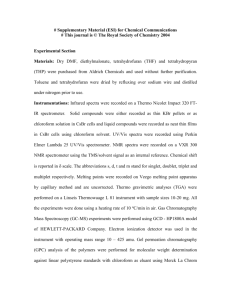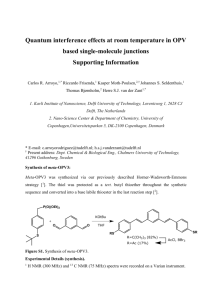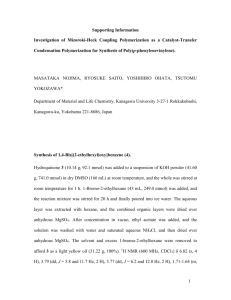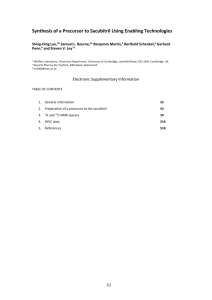nanoparticles: an advanced high-valent magnetic catalyst
advertisement
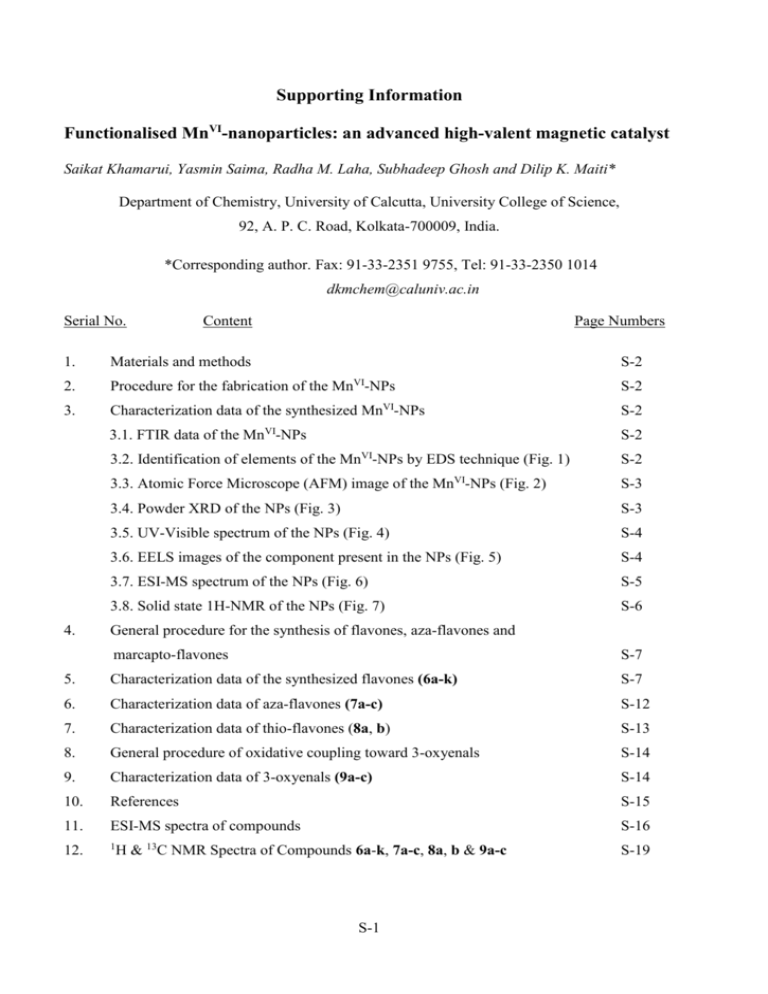
Supporting Information Functionalised MnVI-nanoparticles: an advanced high-valent magnetic catalyst Saikat Khamarui, Yasmin Saima, Radha M. Laha, Subhadeep Ghosh and Dilip K. Maiti* Department of Chemistry, University of Calcutta, University College of Science, 92, A. P. C. Road, Kolkata-700009, India. *Corresponding author. Fax: 91-33-2351 9755, Tel: 91-33-2350 1014 dkmchem@caluniv.ac.in Serial No. Content Page Numbers 1. Materials and methods S-2 2. Procedure for the fabrication of the MnVI-NPs S-2 3. Characterization data of the synthesized MnVI-NPs S-2 3.1. FTIR data of the MnVI-NPs S-2 3.2. Identification of elements of the MnVI-NPs by EDS technique (Fig. 1) S-2 3.3. Atomic Force Microscope (AFM) image of the MnVI-NPs (Fig. 2) S-3 3.4. Powder XRD of the NPs (Fig. 3) S-3 3.5. UV-Visible spectrum of the NPs (Fig. 4) S-4 3.6. EELS images of the component present in the NPs (Fig. 5) S-4 3.7. ESI-MS spectrum of the NPs (Fig. 6) S-5 3.8. Solid state 1H-NMR of the NPs (Fig. 7) S-6 4. General procedure for the synthesis of flavones, aza-flavones and marcapto-flavones S-7 5. Characterization data of the synthesized flavones (6a-k) S-7 6. Characterization data of aza-flavones (7a-c) S-12 7. Characterization data of thio-flavones (8a, b) S-13 8. General procedure of oxidative coupling toward 3-oxyenals S-14 9. Characterization data of 3-oxyenals (9a-c) S-14 10. References S-15 11. ESI-MS spectra of compounds S-16 12. 1 S-19 H & 13C NMR Spectra of Compounds 6a-k, 7a-c, 8a, b & 9a-c S-1 1. Materials and methods. All solvents were dried by standard methods. Unless otherwise specified, chemicals were purchased from commercial suppliers and used without further purification. Column chromatography was performed on silica gel (60-120 mesh). TLC was done on glass sheets pre-coated with silica gel (with binder, 300 meshes, Merck). Scanning transmission electron microscopy (TEM) images and electron energy loss spectrum (EELS) were taken using an ultra-high resolution field emission gun transmission electron microscope (UHRFEG TEM, JEM-2100F, JEOL, Japan) operating at 200 kV. The 1H- and 13C-NMR spectra were taken in CDCl3 with TMS as an internal standard on Bruker Supercon NMR spectrometer (Model: AV 300 Digital). The chemical shifts were reported as values (ppm) relative to tetramethylsilane. Proton multiplicities are represented as s (singlet), d (doublet), dd (double doublet), t (triplet), q (quartet), and m (multiplet). Infrared spectra were recorded on FTIR spectrometer in KBr pellets and in NaCl cell (liquid sample) on a Perkin-Elmer RXI-FTIR spectrophotometer. Melting points of the samples were determined with a Fisher-John melting point apparatus and were uncorrected. HR-MS data were acquired by electron spray ionization technique on a Q-tof-micro quadriple mass spectrophotometer (Bruker). 2. Procedure for the fabrication of the MnVI-NPs. In a 100 mL round bottomed flask, CTAB (364 mg, 1 mmol) and CH2Cl2 (36.4 mL) were taken together and stirred magnetically for 5 min. KMnO4 (158 mg, 1 mmol) was added into the solution and stirring was continued. Me3SiBr (306 mg, 2 mmol) was added drop wise at 0 °C and content of the reaction mixture was stirred for 45 min. Finally the reaction mixture was poured into 200 mL of CH2Cl2 and centrifuged, washed with CH2Cl2 (5 x 20 mL) and dried under reduced pressure at ambient temperature to afford MnVI-NPs as a brown solid material (yield: 52%; 138 mg, 0.52 mmol). 3. Characterization data of the synthesized MnVI-NPs 3.1. FTIR data of the MnVI-NPs (KBr, Cm-1): 453, 511, 754, 1393, 1522, 2922. The following energy dispersive spectrum (EDS) was studied in a field emission scanning electron microscope (FESEM, JEOL, JSM 6700F). 3.2. Identification of elements of the MnVI-NPs by EDS technique. Figure 1 S-2 3.3. Atomic Force Microscope (AFM) image of the MnVI-NPs. AFM image was captured in Agilent5100. Figure 2 3.4. Powder XRD of the NPs. The powder X-ray diffraction pattern was recorded on a Bruker D-8 advance diffractometer operated at 40 kV voltage and 40 mA current and calibrated with a standard silicon sample, using Ni-filtered Cu-Kα (α = 0.15406 nm) radiation. Figure 3 S-3 Absorbance 3.5. UV-visible spectrum of the NPs in CH2Cl2. Electronic absorption spectrum of the high-valent NPs was recorded using a Hitachi U-3501 spectrophotometer. Figure 4 3.6. EELS images of the individual components present in the NPs. EELS of the synthesized Me3SiOMnO2Br-NPs were performed using JEOL TEM machine. Individual and composite elemental mapping of Me3SiOMnO2Br-NPs are displayed in the followings. Br C SiSi H Mn O Figure 5 S-4 3.7. ESI-MS spectrum of the NPs. The exact mass for the metal NPs of formula C3H9BrMnO3Si is 254.8885 and found as 254.8857. Figure 6 S-5 3.8. Solid state 1H-NMR of the NPs. The presence of organic component OSi(CH3)3 in the NPs was also confirmed in the solid sate 1H NMR of nanomaterial which appeared at 1.469. Figure 7 S-6 4. General procedure for the synthesis of flavones, aza-flavones and marcaptoflavones To a solution of salicylaldehyde or 2-amino-3,5-dibromo-benzaldehyde or thio-salicylaldehyde (1.0 mmol) in THF (20 mL) triethylamine (1.1 mmol, 111 mg) was added drop wise under stirring condition. The propargyl ketone (1.0 mmol) was added to it. The MnVI-NPs (10 mol %) and sodium periodate (1.1 mmol, 235 mg) were added and allowed to reflux at 70 oC for 3-4 h. The reaction was monitored by thin layer chromatography (TLC). The solvent of the post reaction mixture was removed under reduced pressure at room temperature and extracted with EtOAc (2x20 mL). The combined organic layer was washed successively with saturated sodium bicarbonate solution (1x10 mL) and brine (3x10 mL). It was dried over anhydrous Na2SO4, filtered and evaporated to dryness in a rotary evaporator under reduced pressure at room temperature. Thus, the reaction with 5-chloro-salicylaldehyde (1.0 mmol, 156 mg) and diethylacetylenedicarboxylate (1.0 mmol, 170 mg) afforded 6-chloro-4-oxo-4H-chromene-2,3dicarboxylic acid diethyl ester (6a) which was isolated after purification by column chromatography on silica gel (60-120 mesh) using ethyl acetate-petroleum ether (1:9, v/v) as an eluent to afford 80% (259 mg, 0.70 mmol) yield. The synthesized flavones derivatives (6a-k), aza-flavones (7a-c) and thio-flavones (8a,b) were characterized by recording NMR (1H and 13C), FTIR and Mass (HR-MS) spectra. The characterisation data of the all new compounds and their spectra are reported in the supporting information. Further, the structure of 6a was confirmed by comparing of the reported spectroscopic data of the compound.1 5. Characterization data of the synthesized flavones (6a-k) 5.1. 6-Chloro-4-oxo-4H-chromene-2,3-dicarboxylic acid diethyl ester (6a) O CO2Et Cl O CO2Et Yield: 80% (259 mg, 0.80 mmol). Characteristic: Yellow oil. 1 H NMR (400 MHz, CDCl3): δ 1.25-1.34 (6H, dt, J = 7.6 Hz), 4.24-4.41 (4H, dq, J = 7.6 Hz), 6.93 (1H, d, J = 9.6 Hz), 7.29-7.31 (1H, m), 7.71 (1H, s). 13 C NMR (100 MHz, CDCl3): δ 13.9, 14.2, 61.5, 63.7, 118.4, 119.5, 122.8, 127.4, 128.3, 132.2, 149.9, 156.2, 163.7, 169.0, 176.6. FTIR (neat, cm-1): 1267, 1453, 1648, 1715, 1753. HR-MS (m/z) for C15H13ClO6 (M+): Calculated 324.0401, found 324.0406 (One of the major peaks). S-7 5.2. 3-Benzoyl-7-bromo-2-phenylchromen-4-one (6b) Yield: 85% (344 mg, 0.85 mmol). Characteristic: Colourless solid. Melting point: 126-129 ◦C 1 H NMR (300 MHz, CDCl3): δ 7.33-7.59 (7H, m), 7.64-7.67 (2H, m), 7.86 (1H, dd, J = 9.0, 2.4 Hz), 7.90-7.93 (2H, m), 8.38 (1H, d, J = 2.4 Hz). 13 C NMR (75 MHz, CDCl3): δ 119.1, 120.1, 122.6, 124.6, 127.1, 128.2, 128.5, 128.7, 128.8, 129.4, 131.3, 131.7, 133.9, 136.8, 137.3, 154.8, 162.7, 175.1, 193.0. FTIR (KBr, cm-1): 1378, 1466, 1640, 1675, 1709. HR-MS (m/z) for C22H13BrO3 (M+): Calculated 404.0048, found 404.0045 (One of the major peaks). 5.3. 3-Acetyl-2-phenylchromen-4-one (6c) O O CH3 O Yield: 72% (190 mg, 0.72 mmol). Characteristic: Yellow thick liquid. 1 H NMR (300 MHz, CDCl3): δ 2.31 (3H, s), 7.18-7.27 (3H, m), 7.28-7.62 (5H, m), 7.63-7.67 (1H, m). 13 C NMR (75 MHz, CDCl3): δ 21.7, 122.1, 126.3, 128.2, 128.4, 128.6, 128.9, 129.2, 129.7, 130.5, 132.7, 134.9, 138.2, 156.5, 162.8, 175.9, 190.5. FTIR (neat, cm-1): 1156, 1268, 1372, 1462, 1644, 1670, 1715. HR-MS (m/z) for C17H12O3 (M+): Calculated 264.0786, found 264.0789. 5.4. 3-Benzoyl-5,7-dichloro-2-phenylchromen-4-one (6d) O Cl O Cl Yield: 83% (328 mg, 0.83 mmol). Characteristic: Colourless solid. S-8 O Melting point: 146-148 ◦C 1 H NMR (300 MHz, CDCl3): δ 7.20 (1H, s), 7.10 (1H, s), 7.18-7.37 (3H, m), 7.40-7.51 (3H, m), 7.56-7.68 (2H, m), 7.74 (2H, d, J = 7.8 Hz). 13 C NMR (100 MHz, CDCl3): δ 123.1, 126.2, 126.5, 126.8, 127.3, 128.3, 128.8, 129.1, 129.4, 129.8, 129.9, 132.2, 132.3, 133.7, 134.5, 136.8, 141.6, 146.9, 157.0, 162.1, 176.3, 194.8. FTIR (KBr, cm-1): 1144, 1259, 1314, 1436, 1551, 1595, 1651, 1706. HR-MS (m/z) for C22H12Cl2O3 (M+): Calculated 394.0163, found 394.0161 (One of the major peaks). 5.5. 2-Benzoyl-3-phenylbenzo[f]chromen-1-one (6e) O O O Yield: 68% (255 mg, 0.68 mmol). Characteristic: Colourless solid. Melting point: 168-169 ◦C 1 H NMR (300 MHz, CDCl3): δ 7.23-7.54 (8H, m), 7.60-7.63 (1H, m), 7.73 (2H, dd, J = 8.1, 1.2 Hz), 7.79-7.90 (4H, m), 7.96 (1H, s). 13 C NMR (75 MHz, CDCl3): δ 118.1, 120.7, 124.5, 125.9, 127.8, 128.1, 128.6, 128.7, 128.9, 129.4, 129.8, 130.2, 130.3, 131.2, 133.1, 136.9, 142.7, 151.5, 162.3, 176.6, 195.5. FTIR (KBr, cm-1): 1227, 1261, 1345, 1391, 1447, 1595, 1629. HR-MS (m/z) for C26H17O3 (M++H): Calculated 377.1178, found 377.1174. 5.6. 3-Benzoyl-2-thiophen-3-yl-chromen-4-one (6f) O O O S Yield: 82% (272 mg, 0.82 mmol). Characteristic: Yellowish solid. Melting point: 117-119 ◦C 1 H NMR (300 MHz, CDCl3): δ 7.01-7.08 (1H, m), 7.23-7.41 (7H, m), 7.46 (1H, d, J = 1.2 Hz), 7.68 (2H, dd, J = 7.8, 1.2 Hz), 8.01 (1H, dd, J = 3.0, 1.2 Hz). 13 C NMR (75 MHz, CDCl3): δ 117.9, 118.2, 123.3, 125.9, 126.0, 128.0, 128.1, 128.5, 128.7, 128.8, 129.8, 134.0, 134.8, 136.7, 156.3, 162.6, 174.1, 195.5. FT-IR (KBr, cm-1): 1291, 1328, 1446, 1488, 1534, 1577, 1628, 1710, 2850. HR-MS (m/z) for C20H12O3S (M+): Calculated 332.0507, found 332.0509. S-9 5.7. 3-Benzoyl-8-methyl-2-(p-tolyl)-chromen-4-one (6g) O O O CH3 CH3 Yield: 76% (269 mg, 0.76 mmol). Characteristic: Colourless solid. Melting point: 160-162 ◦C 1 H NMR (300 MHz, CDCl3): δ 2.25 (3H, s), 2.40 (3H, s), 6.89 (1H, t, J = 7.5 Hz), 7.02 (1H, d, J = 6.9 Hz), 7.11-7.14 (2H, m), 7.20-7.34 (3H, m), 7.44 (1H, t, J = 7.5 Hz), 7.53-7.57 (1H, m), 7.647.68 (2H, m), 7.75 (1H, d, J = 6.9 Hz). 13 C NMR (75 MHz, CDCl3): δ 15.5, 21.6, 121.4, 125.8, 125.9, 126.3, 128.0, 128.4, 128.5, 128.7, 129.2, 129.8, 130.0, 134.0, 134.2, 134.3, 135.5, 136.8, 138.2, 157.2, 162.6, 176.1, 195.4. FTIR (KBr, cm-1): 1179, 1235, 1291, 1364, 1441, 1464, 1578, 1600, 1630, 1708. HR-MS (m/z) for C24H19O3 (M++H): Calculated 355.1334, found 355.1339. 5.8. 3-Benzoyl-8-methoxy-2-(p-tolyl)-chromen-4-one (6h) O O O OCH3 CH3 Yield: 80% (296 mg, 0.80 mmol). Characteristic: Yellow solid. Melting point: 145-146 ◦C 1 H NMR (300 MHz, CDCl3): δ 2.43 (3H, s), 3.83 (3H, s), 6.83-6.87 (1H, m), 6.98 (1H, d, J = 6.6 Hz), 7.14-7.33 (6H, m), 7.48 (1H, dd, J = 3.6 Hz), 7.72 (2H, d, J = 8.1 Hz), 7.82-7.92 (1H, m). 13 C NMR (75 MHz, CDCl3): δ 21.6, 56.3, 112.2, 121.8, 126.0, 126.3, 128.0, 128.3, 128.5, 128.7, 129.2, 129.8, 130.0, 132.3, 133.0, 134.0, 136.7, 152.1, 156.8, 161.1, 175.6, 190.4. FTIR (KBr, cm-1): 1094, 1223, 1384, 1400, 1571, 1638. HR-MS (m/z) for C24H18O4 (M+): Calculated 370.1205, found 370.1207. 5.9. 4-Oxo-4H-chromene-2,3-dicarboxylic acid diethyl ester (6i) O CO2Et O Yield: 65% (188 mg, 0.65 mmol). Characteristic: Yellow oil. S-10 CO2Et H NMR (500 MHz, CDCl3): δ 1.24-1.33 (6H, m), 4.24-4.40 (4H, m), 6.98 (1H, d, J = 8.0 Hz), 7.03 (1H, t, J = 7.5 Hz), 7.30-7.36 (2H, m). 13 C NMR (100 MHz, CDCl3): δ 14.0, 14.2, 61.2, 63.6, 116.9, 118.2, 121.6, 122.5, 129.2, 132.7, 151.5, 157.2, 164.1, 169.3, 176.1. FTIR (neat, cm-1): 1275, 1356, 1446, 1667, 1714, 1760. HR-MS (m/z) for C15H14O6 (M+): Calculated 290.0790, found 290.0794. 1 5.10. 6-Bromo-4-oxo-4H-chromene-2,3-dicarboxylic acid diethyl ester (6j) O CO2Et Br O CO2Et Yield: 87% (321 mg, 0.87 mmol). Characteristic: Yellow oil. 1 H NMR (300 MHz, CDCl3): δ 1.27-1.36 (6H, m), 4.25-4.43 (4H, m), 6.90 (1H, d, J = 7.5 Hz), 7.46 (1H, dd, J = 7.5, 2.1 Hz), 7.73 (1H, s). 13 C NMR (75 MHz, CDCl3): δ 13.8, 14.1, 61.3, 63.6, 114.5, 118.6, 119.9, 122.7, 131.1, 133.6, 150.3, 155.6, 163.5, 168.8, 175.3. FTIR (neat, cm-1): 1206, 1262, 1280, 1470, 1642, 1713, 1751. HR-MS (m/z) for C15H13BrO6 (M+): Calculated 367.9896, found 367.9893 (One of the major peaks). 5.11. 3-Benzoyl-2-phenylchromen-4-one (6k) O O O Yield: 70% (228 mg, 0.70 mmol). Characteristic: Colourless solid. Melting point: 120-121◦C 1 H NMR (300 MHz, CDCl3): δ 7.30-7.60 (7H, m), 7.63-7.79 (4H, m), 7.92 (2H, dd, J = 7.2, 1.5 Hz), 8.25 (1H, dd, J = 7.8, 1.5 Hz). 13 C NMR (75 MHz, CDCl3): δ 118.1, 122.7, 123.3, 125.6, 126.1, 128.5, 128.6, 129.4, 131.4, 131.8, 133.6, 134.3, 137.1, 156.1, 162.4, 176.4, 193.4. FTIR (KBr, cm-1): 1093, 1127, 1268, 1384, 1638, 1687, 1707. HR-MS (m/z) for C22H14O3 (M+): Calculated 326.0943, found 326.0941. S-11 6. Characterization data of aza-flavones (7a-c) 6.1. 3-Benzoyl-6,8-dibromo-2-phenyl-1H-quinolin-4-one (7a) O O Br N Br H Yield: 76% (367 mg, 0.76 mmol). Characteristic: Yellow solid. Melting point: 170-171◦C. 1 H NMR (400 MHz, CDCl3): δ 7.27-7.40 (5H, m), 7.50-7.54 (1H, m), 7.66-7.75 (4H, m), 8.01 (1H, d, J = 2.0 Hz), 8.21 (1H, s), 8.24 (1H, d, J = 2.0 Hz). 13 C NMR (100 MHz, CDCl3): δ 120.5, 126.6, 127.7, 128.6, 129.6, 129.8, 130.0, 133.8, 134.4, 136.6, 137.1, 137.2, 137.4, 138.8, 139.9, 144.1, 158.0, 173.5, 196.3. FT-IR (KBr, cm-1): 1314, 1400, 1448, 1637, 2067. HR-MS (m/z) for C22H13Br2NO2 (M+): Calculated 480.9313, found 480.9317 (One of the major peaks). 6.2. 3-Benzoyl-6,8-dibromo-2-(p-tolyl)-1H-quinolin-4-one (7b) O O Br N Br H CH3 Yield: 80% (397 mg, 0.80 mmol). Characteristic: Colourless solid. Melting point: 196-199 ◦C 1 H NMR (400 MHz, CDCl3): δ 2.37 (3H, s), 6.83 (1H, s), 7.04-7.12 (2H, m), 7.23-7.33 (4H, m), 7.46-7.50 (1H, m), 7.63 (2H, d, J = 6.8 Hz), 7.89 (1H, d, J = 2.4 Hz), 7.90 (1H, d, J = 2.0 Hz). 13 C NMR (100 MHz, CDCl3): δ 21.6, 116.5, 121.8, 125.5, 127.2, 127.3, 128.7, 129.4, 129.5, 129.7, 132.4, 133.0, 135.7, 136.6, 143.4, 144.2, 159.3, 171.8, 190.3. FT-IR (KBr, cm-1): 1298, 1412, 1450, 1640, 1701, 2068. HR-MS (m/z) for C23H15Br2NO2 (M+): Calculated 494.9470, found 494.9472 (One of the major peaks). S-12 6.3. 6,8-Dibromo-4-oxo-1,4-dihydro-quinoline-2,3-dicarboxylic acid diethyl ester (7c) O CO2Et Br N Br CO2Et H Yield: 85% (380 mg, 0.85 mmol). Characteristic: Colourless solid. Melting point: 120-123 ◦C 1 H NMR (300 MHz, CDCl3): δ 1.43 (6H, dt, J = 7.2 Hz), 4.44 (2H, q, J = 7.2 Hz), 4.52 (2H, q, J = 7.2 Hz), 8.05 (1H, d, J = 2.0 Hz), 8.26 (1H, d, J = 2.0 Hz), 8.66 (1H, s). 13 C NMR (75 MHz, CDCl3): δ 14.1, 14.2, 62.4, 62.5, 122.2, 124.3, 126.6, 128.9, 138.9, 139.0, 144.2, 151.1, 164.4, 166.1, 176.3. FT-IR (KBr, cm-1): 1062, 1159, 1264, 1287, 1459. 1584, 1716, 1741. HR-MS (m/z) for C15H13Br2NO5 (M+): Calculated 444.9160, found 444.9164 (One of the major peaks). 7. Characterization data of thio-flavones (8a,b) 7.1. 4-Oxo-4H-thiochromene-2,3-dicarboxylic acid diethyl ester (8a) O CO2Et S CO2Et Yield: 70% (214 mg, 0.70 mmol). Characteristic: Yellow solid. Melting point: 123-125 ◦C 1 H NMR (300 MHz, CDCl3): δ 1.15-1.27 (6H, m), 4.15-4.34 (4H, m), 6.90-6.99 (2H, m), 7.237.31 (2H, m). 13 C NMR (100 MHz, CDCl3): δ 13.8, 14.1, 61.1, 63.4, 116.8, 118.1, 121.5, 122.4, 129.0, 132.5, 135.1, 151.3, 163.9, 169.2, 186.8. FTIR (KBr, cm-1): 1296, 1366, 1458, 1571, 1607, 1641, 1704, 1736. HR-MS (m/z) for C15H14O5S (M+): Calculated 306.0562, found 306.0567. 7.2. 3-Benzoyl-2-phenylthiochromen-4-one (8b) O O S Yield: 56% (191 mg, 0.56 mmol). Characteristic: Colourless solid. S-13 Melting point: 156-159 ◦C 1 H NMR (300 MHz, CDCl3): 7.19-7.48 (8H, m), 7.55-7.64 (4H, m), 8.15-8.17 (4H, m). 13 C NMR (75 MHz, CDCl3): δ 120.1, 128.6, 129.5, 130.7, 133.0, 134.0, 136.9, 152.3, 178.0, 187.4. FTIR (KBr, cm-1): 1271, 1345, 1578, 1612, 1650, 1706, 1710, 1732. HR-MS (m/z) for C22H14O2S (M+): Calculated 342.0715, found 342.0712. 8. General procedure of oxidative coupling toward 3-oxyenals (9) To a solution of salisaldehyde (1.0 mmol) and another aldehyde (1.0 mmol) in THF (20 mL) triethylamine (1.1 mmol, 111 mg) was added drop wise under stirring conditions. The propargyl alcohol (1.0 mmol) was added to it. The MnVI-NPs catalyst (10 mol %, 26 mg) and sodium periodate (1.1 mmol, 235 mg) were added and allowed to reflux at 70 oC for 4 h. The reaction was monitored by thin layer chromatography (TLC). The solvent was removed from the post reaction mixture in a rotary evaporator and the residue was extracted with EtOAc (2x20 mL). The combined organic layer was washed successively with saturated sodium bicarbonate solution (1x10 mL) and brine (2x10 mL). It was dried over anhydrous Na2SO4, filtered and evaporated in a rotary evaporator under reduced pressure at room temperature. Thus, the three component cyclisation reaction of salicylaldehyde (2.0 mmol, 244 mg) with 3-phenyl-2-propyn-1-ol (1.0 mmol, 132 mg) afforded 3-oxyenal (9a) which was isolated after purification by column chromatography on silica gel (60-120 mesh) using ethyl acetate-petroleum ether (1:9, v/v) as an eluent in an yield of 70% (261 mg, 0.70 mmol). The synthesized compounds (9a-c) were characterized by means of NMR (1H and 13C), FTIR, Mass (HR-MS) spectral analysis. 9. Characterization data of 3-oxyenals (9a-c) 9.1. 2-[3-Formyl-4-hydroxy-4-(2-hydroxyphenyl)-2-phenyl-but-2-enyl]benzaldehyde (9a) OH OH OHC O CHO Yield: 70% (261 mg, 0.70 mmol). Characteristic: Yellow oil. 1 H NMR (300 MHz, CDCl3): δ 1.68 (1H, s), 5.58 (1H, s), 6.98 (1H, t, J = 7.5 Hz), 7.07-7.12 (1H, m), 7.16-7.26 (2H, m), 7.32-7.45 (3H, m), 7.52-7.60 (4H, m), 7.67-7.72 (2H, m), 9.57 (1H, s), 9.88 (1H, s), 11.45 (1H, s). 13 C NMR (75 MHz, CDCl3): δ 76.0, 115.4, 116.5, 119.7, 120.9, 124.0, 125.2, 127.9, 128.0, 128.4, 128.5, 129.4, 130.2, 131.2, 131.6, 132.5, 133.5, 136.5, 149.9, 158.9, 168.1, 190.5, 196.5. FTIR (neat, cm-1): 1408, 1457, 1538, 1570, 1606, 1654, 1666. HR-MS (m/z) for C23H18O5 (M+): Calculated 374.1154, found 374.1152. S-14 9.2. 2-[3-Formyl-4-hydroxy-4-(4-nitrophenyl)-2-phenyl-but-2-enyl]benzaldehyde (9b) OH OHC O NO2 CHO Yield: 76% (306 mg, 0.76 mmol). Characteristic: Yellow oil. 1 H NMR (400 MHz, CDCl3): δ 2.41 (1H, s), 5.60 (1H, s), 6.96 (1H, d, J = 6.8 Hz), 7.19 (1H, d, J = 2.0 Hz), 7.25-7.35 (4H, m), 7.45 (2H, t, J = 6.0 Hz), 7.57-7.63 (1H, m), 7.65 (2H, d, J = 6.0 Hz), 7.76 (2H, d, J = 6.0 Hz), 9.61 (1H, s), 10.14 (1H, s). 13 C NMR (100 MHz, CDCl3): δ 75.0, 118.6, 120.0, 124.4, 125.6, 127.0, 128.0, 128.3, 128.6, 128.7, 129.0, 130.6, 131.5, 131.8, 132.6, 133.6, 134.7, 140.2, 151.3, 154.6, 162.8, 190.3, 192.9. FTIR (neat, cm-1): 1409, 1449, 1528, 1575, 1609, 1650, 1667. HR-MS (m/z) for C23H17NO6 (M+): Calculated 403.1056, found 403.1052. 9.3. 2-[3-(4-Bromophenyl)-2-formyl-3-hydroxy-1-phenylpropenyloxy]benzaldehyde (9c) OH OHC O Br CHO Yield: 65% (284 mg, 0.65 mmol). Characteristic: Yellow oil. 1 H NMR (300 MHz, CDCl3): δ 2.23 (1H, s), 5.19 (1H, s), 6.98 (1H, d, J = 6.0 Hz), 7.21-7.49 (5H, m), 7.47-7.49 (2H, m), 7.58-7.63 (3H, m), 7.77 (2H, d, J = 8.4 Hz), 10.16 (1H, s), 10.38 (1H, s). 13 C NMR (75 MHz, CDCl3): δ 75.1, 115.6, 116.4, 122.0, 124.1, 125.2, 127.5, 128.0, 128.3, 128.5, 128.6, 129.4, 130.2, 131.2, 131.4, 131.7, 132.5, 133.3, 136.7, 157.6, 167.3, 191.1, 195.7. HR-MS (m/z) for C23H17BrO4 (M+): Calculated 436.0310, found 436.0313 (One of the major peaks). 10. Reference 1. M. Yoshida, K. Saito, Y. Fujino, Y. Fujii, T. Doi*; Chem. Commun., 2012, 48, 11796–11798. S-15 11. ESI-MS spectra of some representative compounds SI Figure 9: ESI-MS spectrum of compound 6a SI Figure 10: ESI-MS spectrum of compound 6b S-16 SI Figure 11: ESI-MS spectrum of compound 7a SI Figure 12: ESI-MS spectrum of compound 8a S-17 SI Figure 13: ESI-MS spectrum of compound 9a S-18 12. 1H and 13C spectra of the compounds (6a-k, 7a-c, 8a-b, 9a-c) SI Figure 14: 1H and 13C-NMR spectra of compound 6a O CO2Et Cl O S-19 CO2Et SI Figure 15: 1H and 13C-NMR spectra of compound 6b O Br O S-20 O SI Figure 16: 1H and 13C-NMR spectra of compound 6c O O CH3 O S-21 SI Figure 17: 1H and 13C-NMR spectra of compound 6d O Cl O Cl S-22 O SI Figure 18: 1H and 13C-NMR spectra of compound 6e O O S-23 O SI Figure 19: 1H and 13C-NMR spectra of compound 6f O O O S S-24 SI Figure 20: 1H and 13C-NMR spectra of compound 6g O O O CH3 CH3 S-25 SI Figure 21: 1H and 13C-NMR spectra of compound 6h O O O OCH3 CH3 S-26 SI Figure 22: 1H and 13C-NMR spectra of compound 6i O CO2Et O S-27 CO2Et SI Figure 23: 1H and 13C-NMR spectra of compound 6j O CO2Et Br O S-28 CO2Et SI Figure 24: 1H and 13C-NMR spectra of compound 6k O O S-29 O SI Figure 25: 1H and 13C-NMR spectra of compound 7a O Br N Br S-30 H O SI Figure 26: 1H and 13C-NMR spectra of compound 7b O O Br N Br H CH3 S-31 SI Figure 27: 1H and 13C-NMR spectra of compound 7c O CO2Et Br N Br S-32 H CO2Et SI Figure 28: 1H and 13C-NMR spectra of compound 8a O CO2Et S CO2Et S-33 SI Figure 29: 1H and 13C-NMR spectra of compound 8b O S S-34 O SI Figure 30: 1H and 13C-NMR spectra of compound 9a O O O S-35 OH OH SI Figure 31: 1H and 13C-NMR spectra of compound 9b O O O S-36 OH NO2 SI Figure 32: 1H and 13C-NMR spectra of compound 9c OH OHC O CHO S-37 Br




